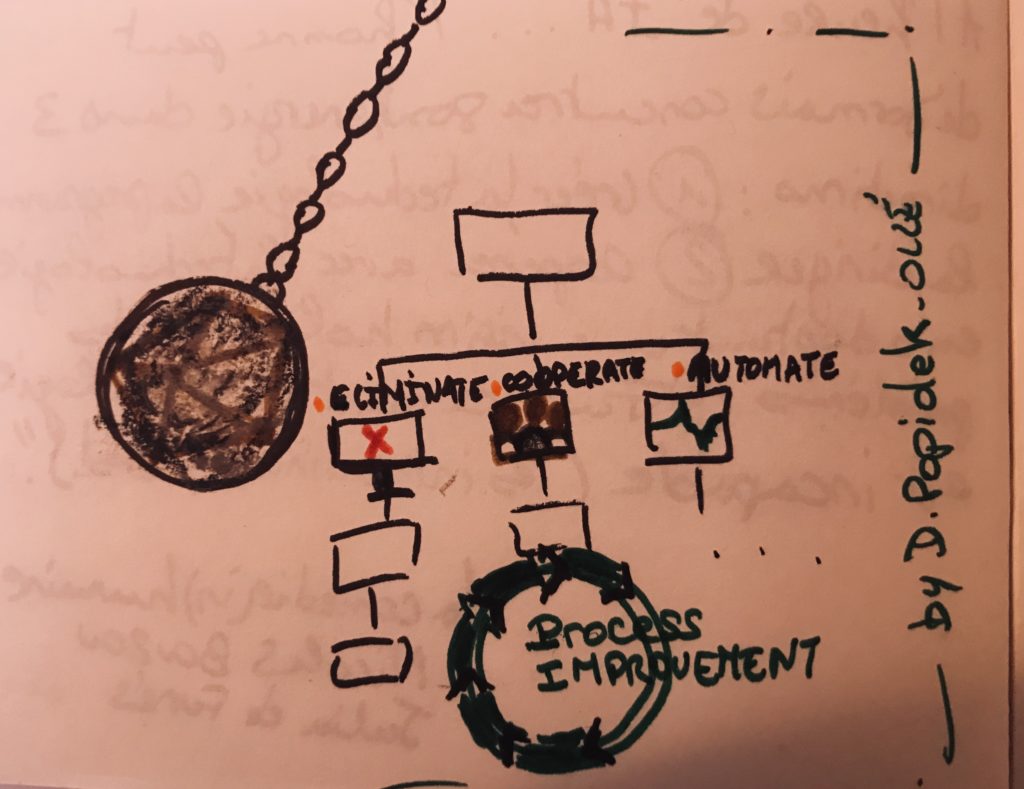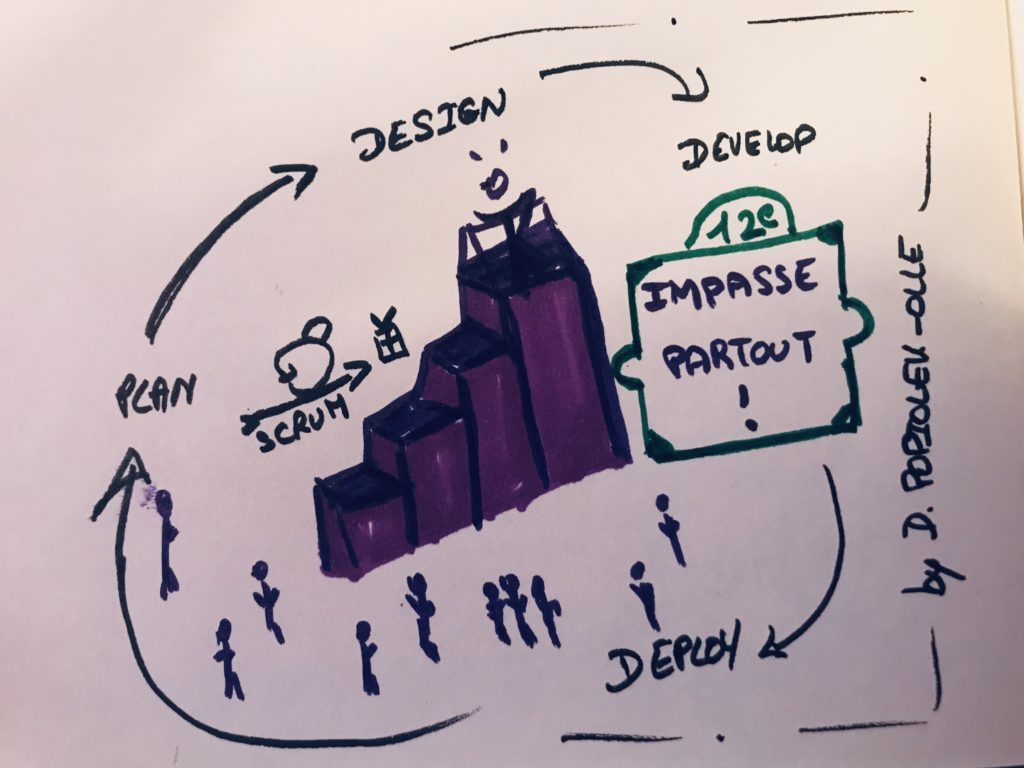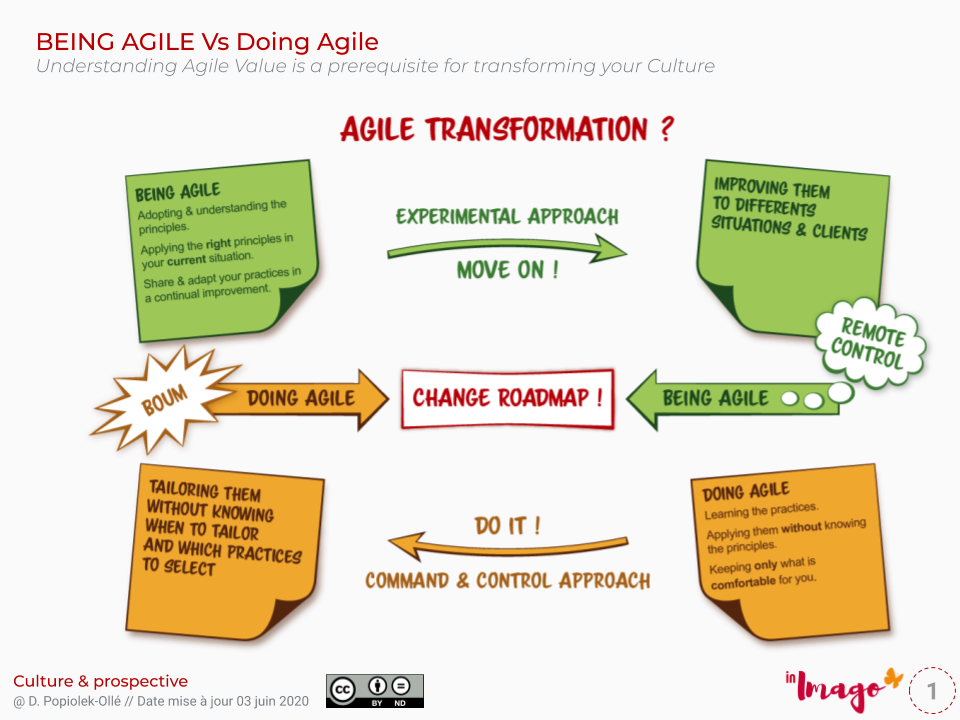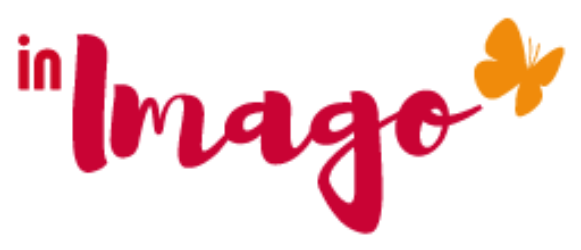The Agile system brings together all the tools and working frameworks useful to support a company in its change of culture in order to manage interactions between stakeholders in a dynamic way and to achieve autonomy, consistency and permanence in the organizational model.
Some will talk about Agile culture or Agility at scale. However, the use of this term is inappropriate in a business. Being Agile is not an end in itself. The company borrows Agility to reach its full potential, to support its talents to find their place in the structure. The company puts Agile in its DNA and adds its values, its mission, its vision to build its footprint and develop its market.
Agile is a self-sustaining framework. The corporate culture becomes learning. It abandons its historical know-how until the emergence of its personalized market: persona.
His persona. It is the perfect knowledge of his client. This is uniqueand the brand owes it a tailor-made product to enhance / bring out its difference. The company trades its know-how in “mass production” to welcome its customer in its center. This will give birth to the customer journey, which will transform with it the traditional processes of manufacturing a product or a service. This will overturn the well-established hierarchical order of the company and bring business processes back to normal.
Each customer journey is unique. The various associated customer journeys will create meaning, outline the mission that the company pursues through the sale of its products. The company becomes the echo of the customer experience.
Nike’s mission, for example, is to bring inspiration and innovation to every athlete * around the world. Each body is an athlete in the making, who sometimes just needs to assert himself. Nike offers this possibility to every sneaker owner …
The company will then have to modify and transform its processes so that the meaning it displays becomes a reality, a real corporate DNA. It will then talk about customer culture, adaptive culture, or Agile culture to explain the means she used to define herself.
Agile system

A company is an ecosystem in which different operational sub-systems coexist to produce a product or a service.
Operation is said to be Agile when the operational components collaborate in synergy to anticipate or capture change, whether internal or external, in order to dynamically compensate for it, then to integrate it.
The diagram opposite is an interpretation of an Agile system.
Each subsystem is autonomous and integrates the entire global operating principle in order to transform an idea into a product. It features:
- of a working framework proposal
- tools to help implement
When the company fully integrates its eco-system, it then develops operational agility.
This Agility at scale can also be simulated using an Agile @ Scale framework and specific tools to address the strategic management of the company.
The challenges of the Agile system: transformation, work environment, collaboration …
The Agile Manifesto of 2001 laid the foundations for common sense to be found in developing quality software, when it is needed.
The Manifesto brought much more than that! It is a reminder to simplicity, to daily and regular contact with its customers and employees for better collective efficiency and implementation at the right time. In 20 years, the manifesto and the associated values have imposed themselves. The values are expressed well beyond the CIOs (Information Systems Department) by bringing a new digital dimension to the company. The IT department becomes the Digital Department. The CDO (Chief digital officer) will support the entire company in its digital transformation. For this, it will rely on Agility at scale.
Agility at scale addresses three major concerns:
- Agile at scale includes the overall transformation of a company: which represents a great job on the corporate culture but also on the transition from a project organization to a product-oriented organization.
- The establishment of a framework to make several Agile teams work together.
- Support the transformation, understand the added value of the teams, keep the right pace over time while preserving motivation and commitment intact.
1-Starting point for a business transformation
The transformation of the company is a voluntary choice of strategic management to develop the company in accordance with the strategic objectives defined for the future. These change initiatives involve the efforts of everyone, both employees and general management, to modify more or less profoundly the structuring elements of the organization in place. The transformation of a company makes it possible to update its organization and associated knowledge, and to anticipate the needs of its customers and employees. The change management becomes continuous.
The vision, the strategic plan, can be the starting point of a transformation, or even an awareness as the dynamic spiral tends to demonstrate in a visualization of the structuring evolutions of the organization. Related to a company, the major changes show a social divide between power and its employees, or between the company and its competitors. The choice to transform “structurally” is necessarily voluntary and follows a major upheaval (loss of turnover, obsolescence, health crisis, etc.)
Organizational transformation consists of rethinking the structure, mode of operation and professional practices of an organization in order to do better and differently.
Therefore, the transformation is part of a proactive approach, driven by strategic management, to significantly improve the efficiency of the organization and / or the satisfaction of stakeholders.
Business transformation moves a complete system, transforming in its path:
- Organizational structure
- The managerial structure
- Information systems
- Business processes
- The culture of the company itself
- The relationship to work and ethics
2- Agile system frameworks and tools

Frameworks and tools for the team
The main frameworks and reference tools for the team are:
1- Scrum
Frameworks and tools for strategic management
The main frameworks and tools for strategic management are
SAFe, Scale Agile Framework is the organizational model that tends to impose itself for an Agile at scale.
Spotify,is an organization that interacts in tribes
Less, Large Scale Scrum allows you to deploy Scrum at the scale of an organization
3- Support the transformation
Henrik Kniberg, one of the pioneers of Agile deployment, in fact said that: “Being agile is not a single solution, and it is ESPECIALLY NOT the ultimate goal. “. Users are full-fledged players, but we have to be able to understand it at all levels.
The Agile system is an impulse, an invitation to modify its behavior. The oscillating ball that will invite your strategic management to step out of its comfort zone.
The Oscillating Ball: necessary impetus for effective management
From business to business, from transformation to transformation, I often come up against the syndrome of the dispersed team, to see nonexistent except in the count of the resources of the information systems.
I have long thought that this was due to a status quo maintained at high level, to maintain the various privileges associated with the right to know: control information, its network to better assert its authority.s

Today I am not so sure. Indeed, the meteoric success of some start-ups and that of GAFAM are proof of a paradigm shift. Social networks argue that times have changed, that generation Y is incontrollable, that datas and user-experience are the masters of a product-and-customer-oriented business success. Managers are now convinced, they are ready to move.
Employees as for them, have been dreaming for at least 10 years: they expect meaning to re-invest, that only a management in action can offer.
2019, offers us a perspective of reconciliation between a management who asks to be active and collaborators to get involved.
3 steps to the swing ball
It only misses … the oscillating ball for effective management.
All of them are wondering what to do and often opt for a process or a method that they empty in their haste of substance to keep only a tool or a simplified-miracle process. Managers are looking for a tool, a way to cling to the breadth of movement impulse by others – such as happiness at work represented by a table football and sofas around a television, or by the multiplication of serious games to reinforce the team spirit, or even Agile and Scrum that promise in addition to usability, efficiency-profitability to those who know how to tame them.
But what is the use of a foosball or a sofa if it is common knowledge that to use it has been fleimard!
So, let’s take the oscillating ball, relax our tensions and our fears to enter the action in 3 steps.
- Eliminate the tasks without added value: all those which do not have utility product-client, and especially give up the post card related to the bonus which prevents the mutual aid and the focus on the objectives to added value.
- Let’s collaborate instead of preserving our silos by establishing once and for all the principle that each employee can work with whom he or she feels good and that each person, individually or in subgroups, can contribute to the organization and the simplification of processes, by choosing his mode of work.
- Automate what takes us time and delegate to companies the achievements of our future automaton to finally reconcile the man and the machine by letting man do what the technology is incapable. Manage the interactions between individuals.
Arm us with courage. Managers you are almost there. Start in the action and the path will be drawn before you
The tools and processes, there are many, will help you in due course. Make agile context but not Agile because Spotify or Safe or Scrum offers you a process.

Questioning the system, and its management, is an asset in preventing the system from freezing. Imposing a framework does not prevent deadlock UNLESS you give yourself the means to overcome each obstacle.
It also means allowing your managers to go beyond appearances, to overcome the tension between proclaimed values, such as alignment and transparency, and operational reality.
I thank the companies that trust me and all my partners who encourage me on a daily basis and dedicate this article to you.
Advantages and disadvantages of the Agile system
Agile doesn’t work! This cannot be decreed … In Why employees love Scrum and bosses not, I give you a 7-year feedback on how to deploy Agile at scale and the resistance I encountered.
A major advantage: flexibility
The major advantage of the Agile approach is its flexibility. Customer changes and unforeseen events are taken into account and the project team can react quickly. Communication and collaboration of all stakeholders with the client establishes a climate of trust.
The client has better visibility on the progress of the project and can thus adjust it according to his needs. The team in which the client is involved integrates continuous improvement in which quality control is constant. The balance sheet of the value produced makes it possible to establish the budget: remaining budget – spent budget. Theoretically, you can therefore decide to stop or continue the development at any time. The customer is a stakeholder, so he can freely agree to grant more budget …
Vigilant point
As dialogue is privileged, the client must be available and take an interest in his project in order to ensure that it will perfectly meet his needs. Not all clients have the time or the inclination to get fully involved in the realization of a project. Businesses around this role have developed as product manager, or product owner, but the role of budget / value adjustment is distorted since very often the product manager is a stakeholder and employee of the company.
On the other hand, the hierarchical structure must accept a collaborative functioning which develops micro products that fit together in order to take into account customer flexibility. The overall budget is therefore built by iteration. Self-management of a team cannot be decreed. It supports itself.
It depends on the agreement of all the stakeholders to move towards increased flexibility, where everyone at their level assumes full responsibility. Adopting Agile values is therefore not only a decision of Top management but also respect for the 3 issues described below.
Adopt Agile values
Adopting Agile values cannot be decreed!
Adopting Agile values on a daily basis requires management willingness, employee freedom, an adapted organizational system, an adapted and adaptive Customer culture.
The Agile Manifesto in 2001 laid the foundations for common sense to be found in order to develop quality software, when it is needed.
The Agile values provided were much more than that! Agile values are a reminder to simplicity, to daily and regular contact with its customers, its employees for better collective efficiency, to implementation as desired.
Agile values can be found everywhere and go well beyond the CIOs – Information Systems Department or company IT departments.
For feedback, discover my Article on the Agile Manifesto, Agile values , and associated principles according to 3 focuses:
- Focus Intensio : Agile values for the team
- Focus Mago : Agile values for each individual
- Focus Extensio : Agile values for the organization
So ready to adopt Agile values?
The 3 challenges of adopting Agile values
Remember
Edouard Capaldi in his video challenges us by showing fashionable “Agile Kudos” with the download of a “Spotify” organization mode. The nod to Lean Management where every company in the late 90s wanted to do Lean and … failed …

The 3 challenges of adopting an Agile value are:
- Challenge 1: Employees are the driving forces behind the adoption of Agile values
- Challenge 2: Agile values are customer-centric
- Challenge 3: Strategic management is involved and responsive
Challenge 1: Employees are the driving forces behind the adoption of Agile values
Agile values are not a fad but wanted by employees. Employees who have undergone successive transformation plans adopt Agile values as soon as they understand the value mechanism and trust is established between the different layers of management.
Employees are therefore a formidable lever for transformation that the company must encourage.
Challenge 2: Agile values are customer centric
There is no adoption of Agile values without the desire to profoundly transform the way to serve the needs of its client.
The customer, in an individual and specific relationship, is the object of everyone’s attention.
Time-to-market is in this sense one of the major elements of the customer relationship in the broad sense in this adoption of Agile values.
Agile values allow the establishment of a lasting, efficient and engaged customer relationship. This is why customer culture is at the heart of management 3.0 valeurs.
Challenge 3: Strategic management is involved and responsive
No adoption of Agile values without a commitment from strategic management. Strategic management is the guarantor of the development of everyone’s skills and their ambition for the long term of the company.
Strategic management will endeavor to develop the 10 points of resilience necessary for the good function of Agile values.

What are the levers provided by Agile values?
The Agile values adopted by employees then become a formidable lever of operational excellence and a productivity booster.
The teams enter into a FLOW which emerges naturally from the association of their skills and their desire to do things. The Flow and associated living management called or symbiocracy is explained here.
Daily contact with customers allows everyone to measure the value of the work produced and to maintain a sense of what is produced. It is no longer a link in the process but the daily creation of a product specifically designed for the customer. In this sense, Agile values are the major levers of a process-oriented product culture transformation towards a product-value-oriented customer culture.
The company in its organizational system, simplifies its organization to focus on the value produced and the well-being of everyone: employees and customers.
Adopting Agile values is the first step in an effective transformation towards the creation of the Flower of Life of an organic business
Read also towards an organic management
To find out more about Agile values and its deployment, read Harvard Business’s Special Edition Agile Must
Author: Dominique popiolek-Ollé, Transmutation leader, Agile Executive Coach, Founder of In Imago management consulting and disruptive transformation.
Special thanks to Alexender Hauesler for the top illustration.
Traduction by Noemie Betukumesu
Agile System: Where to start?
To support you, we are grouping our content together to offer you a step-by-step approach. Please send us your comments so that this content evolves into kits that you can easily use.
